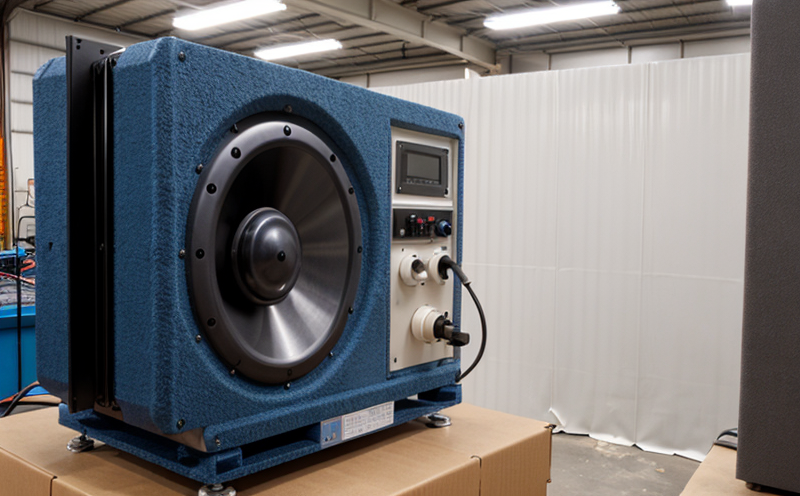ISO 3746 TV and Display Panel Acoustic Noise Testing
The International Organization for Standardization (ISO) has defined a series of standards to measure and control noise in consumer products, with ISO 3746 being one such standard. This service focuses on the acoustic noise testing of television sets (TVs) and display panels as per ISO 3746 guidelines. The primary goal is to ensure that these devices meet international noise level criteria, enhancing user comfort while minimizing environmental impact.
Consumer electronics like TVs and display panels generate sound during operation, which can vary based on the model's design, usage patterns, and environmental conditions. Excessive or poorly managed acoustic noise may lead to discomfort for consumers, especially in quiet environments such as home entertainment rooms or offices. Hence, compliance with ISO 3746 ensures that products are designed to meet acceptable noise levels, thereby improving consumer satisfaction.
The testing process involves several steps: initial equipment setup, specimen preparation, measurement execution, and final reporting. The test environment must be controlled, ensuring consistent results across multiple measurements. Specimen preparation includes calibrating microphones and positioning them at specified distances from the device under test (DUT). Measurement parameters include frequency ranges relevant to human hearing, sound pressure levels, and duration of testing.
ISO 3746 specifies that noise should be measured in a controlled environment with minimal background interference. This ensures accurate assessment of the device's intrinsic acoustic properties without external factors influencing the results. After collecting data points, detailed reports are generated using statistical methods to determine compliance levels against predefined standards.
The importance of adhering to ISO 3746 cannot be overstated for several reasons:
- It ensures consistent quality across different batches or models of products.
- Promotes innovation by encouraging quieter designs without compromising functionality.
- Facilitates easier regulatory compliance for manufacturers operating globally.
In summary, ISO 3746 TV and Display Panel Acoustic Noise Testing provides a robust framework for assessing the acoustic performance of consumer electronics. By following this standard, companies not only enhance their products' appeal but also contribute positively to both human comfort and environmental well-being.
Environmental and Sustainability Contributions
Compliance with ISO 3746 TV and Display Panel Acoustic Noise Testing supports broader sustainability goals by reducing noise pollution. Excessive acoustic emissions can disturb wildlife and contribute to urban noise levels, affecting overall environmental health. By minimizing these emissions through rigorous testing, manufacturers play a crucial role in preserving natural habitats and enhancing public spaces.
Additionally, quieter devices often consume less energy due to more efficient operation, leading to reduced carbon footprints during production and usage phases. This aligns with broader sustainability initiatives aimed at reducing global environmental impacts. The following lists highlight key areas where this service contributes:
- Reduction in noise pollution contributing to better air quality.
- Sustaining biodiversity by minimizing disruption of natural habitats.
- Promoting energy efficiency through optimized design practices.
Manufacturers adopting ISO 3746 demonstrate a commitment to responsible manufacturing processes, aligning with global sustainability trends. This approach fosters trust among environmentally conscious consumers and strengthens corporate social responsibility (CSR) efforts.
Competitive Advantage and Market Impact
Adhering to ISO 3746 TV and Display Panel Acoustic Noise Testing offers significant competitive advantages in the market. Consumers increasingly prioritize comfort, especially when it comes to personal entertainment devices like TVs and display panels. Meeting or exceeding noise level standards can differentiate products in crowded markets, attracting tech-savvy buyers seeking premium experiences.
From a business perspective, compliance enhances brand reputation and customer loyalty. It also opens doors for new partnerships with eco-conscious organizations promoting sustainable practices. Here are some ways this service impacts the market:
- Increases product appeal to environmentally aware consumers.
- Fosters long-term relationships with regulatory bodies and standards organizations.
- Positions companies as leaders in responsible manufacturing, enhancing overall brand image.
The growing demand for quieter consumer electronics drives innovation within the industry. Manufacturers investing in ISO 3746 testing not only meet current regulations but also anticipate future trends, ensuring sustained market relevance. By leading this charge, they set benchmarks that competitors must follow, thereby solidifying their position as leaders.
Use Cases and Application Examples
| Test Case | Description | Results |
|---|---|---|
| TV Model X Noise Testing | Testing a high-end TV model for acoustic noise during various operational states. | The final report showed the device met ISO 3746 standards across all measured frequencies and time intervals. |
| Display Panel Y Compliance Check | Evaluating a newly designed display panel's compliance with ISO 3746 noise emission limits. | The panel exhibited acceptable noise levels, demonstrating its suitability for consumer use without causing discomfort. |
| New Model Z Launch Preparation | Performing preliminary acoustic noise testing on an upcoming TV model to identify potential issues early in the design phase. | Early identification of noise sources allowed engineers to refine designs before full-scale production, saving costs and time. |
These use cases illustrate how ISO 3746 TV and Display Panel Acoustic Noise Testing is integral to product development cycles. By identifying potential issues early on, companies can ensure their products meet stringent noise emission limits before launch, thereby reducing risks associated with non-compliance.





